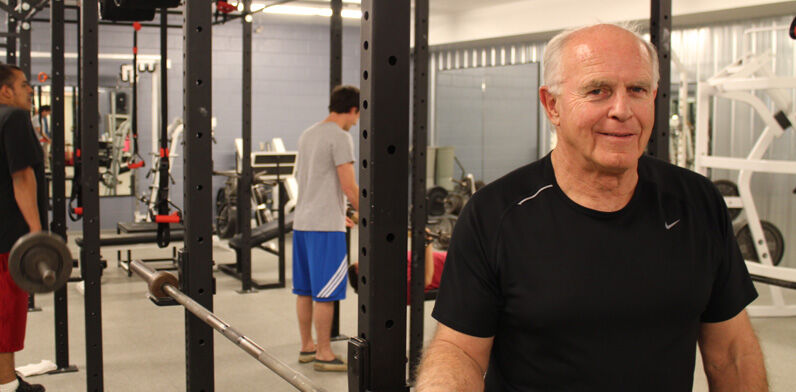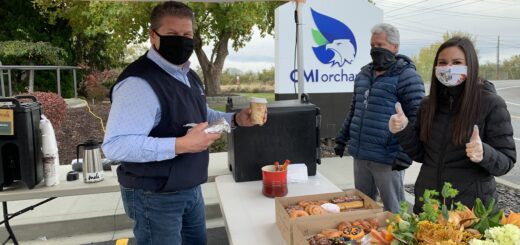With little fanfare, Sandy Cooprider made astonishing contributions to WVC, community
The Sandy Cooprider Sport Field Complex at Wenatchee Valley College is one of the most extraordinary examples of community building in North Central Washington, a field of dreams that started with the vision of the former coach and athletic director who spent 44 years at the college.
What has been achieved ranks close to the top of the most audacious and improbable achievements in the valley’s history. I stand in awe of what has been accomplished.
Cooprider, who came to WVC in 1971, had the long-range vision, leadership and relentless determination to transform undeveloped fields and create first-rate college athletic facilities (without state or college financial support). To pull it off, Cooprider built a loyal following of supporters who invested time, energy and financial resources to make the dream come true.
The complex, Wenatchee’s own field of dreams, includes Paul Thomas Sr. Baseball Stadium, North Rotary Fastpitch Field, Mike Hollis Soccer Field and a multipurpose field. Cooprider will be honored at an Applesox home game June 8.
The WVC Knights football program was a key catalyst for building the Cooprider’s field of dreams because it had a legion of local supporters, athletic director Greg Franz recalled. When football was dropped, Cooprider saw the opportunity to use the athletic facilities and build other opportunities for students to participate in the campus and those football supporters backed him up.
Because of Cooprider’s dogged persistence and the generosity of local businesses and organizations led by Oneonta Starr Ranch Growers, Goodfellow Bros. Selland Construction, Wenatchee North Rotary and a host of other organizations, men and women who attend WVC have opportunities to play competitive sports in first-rate facilities. Beyond that, it created the opportunity for the Wenatchee Applesox to have a quality place to play their home games and countless high school students have participated in tournaments on those fields.
What makes this complex noteworthy is that no funds from the college or from the state were available to be used. Administrators told Cooprider that he was welcome to pursue his dream of upgrading facilities but there would be no financial support forthcoming. They didn’t tell him no and so he went to work to see what could be accomplished. A hands-on kind of guy, Cooprider learned to drive various kinds of equipment and logged countless hours out on the fields.
I can’t imagine many individuals, faced with the task at hand and no administration support, would have pursued Cooprider’s Quixotesque vision.
But Cooprider took that as a challenge and went to work. It’s important to note that Cooprider at the time was just a part-time athletic director, who had been coaching football and baseball, as well as teaching on campus.
Cooprider’s first effort, recalled Dalton Thomas of Oneonta Starr Ranch Growers, was getting funding for handball courts. Dalton and his brother Herb helped out financially, which was the beginning of an important collaboration.
Their father, Paul Thomas Sr., one of the founding owners of the Wenatchee Chiefs minor league baseball team, learned about the Cooprider’s vision of a first-rate baseball field and the elder Thomas pledged $400,000 to help support it. That got the ball rolling.
The baseball field was built with donated materials, surplus seats from the Kingdome, and a whole lot of sweat equity from countless individuals, team members and businesses. Cooprider cajoled the lighting company into donating two-thirds of the cost of the stadium lights. What excited them was the field of dreams aspect to the Paul Thomas Sr. Field, with community members pitching in as if it was a barn raising back in the early days.
When the concession and restroom facility was constructed, the electrician’s union provided apprentice electricians to do the wiring. Every part of the complex was created by this barn-raising mindset.
The stadium was refurbished in 2013 and, in honor of the late Paul Thomas Sr., who was drafted by the Boston Red Sox after college, all of the structures were painted the same green color as Fenway Park, along with other improvements.
Dalton Thomas said it’s a thrill for him to attend games at the field named for his father. Of Cooprider, he said this: “We’re lucky to have him in this community, especially Wenatchee Valley College.”
Cooprider’s persistence and can-do spirit were essential to the development of the sports complex. This was something he got from his mother, a single mom who struggled to make ends meet but who remained positive and optimistic regardless of the circumstances. He came to WVC in 1971 and finally retired from teaching in 2015. How many students did he interact with in all of those years of coaching and teaching? Maybe 8,000, he said.
I have to believe that Cooprider made as much of a lasting impact on students and student-athletes as he did when building the sports complex at Wenatchee Valley College.
As Dalton Thomas pointed out, he’s a tough guy to say “no” to. His smiling persistence allowed him to build the relationships that made the WVC Sport Field Complex a community-built gem.
Had the college paid to make those improvements, it would have amounted to many millions of dollars. Now that’s a legacy worth celebrating. Let us appreciate what he’s done and bring that kind of passion, energy and perseverance to community projects that we are involved with. Sandy Cooprider has lighted the path forward.




